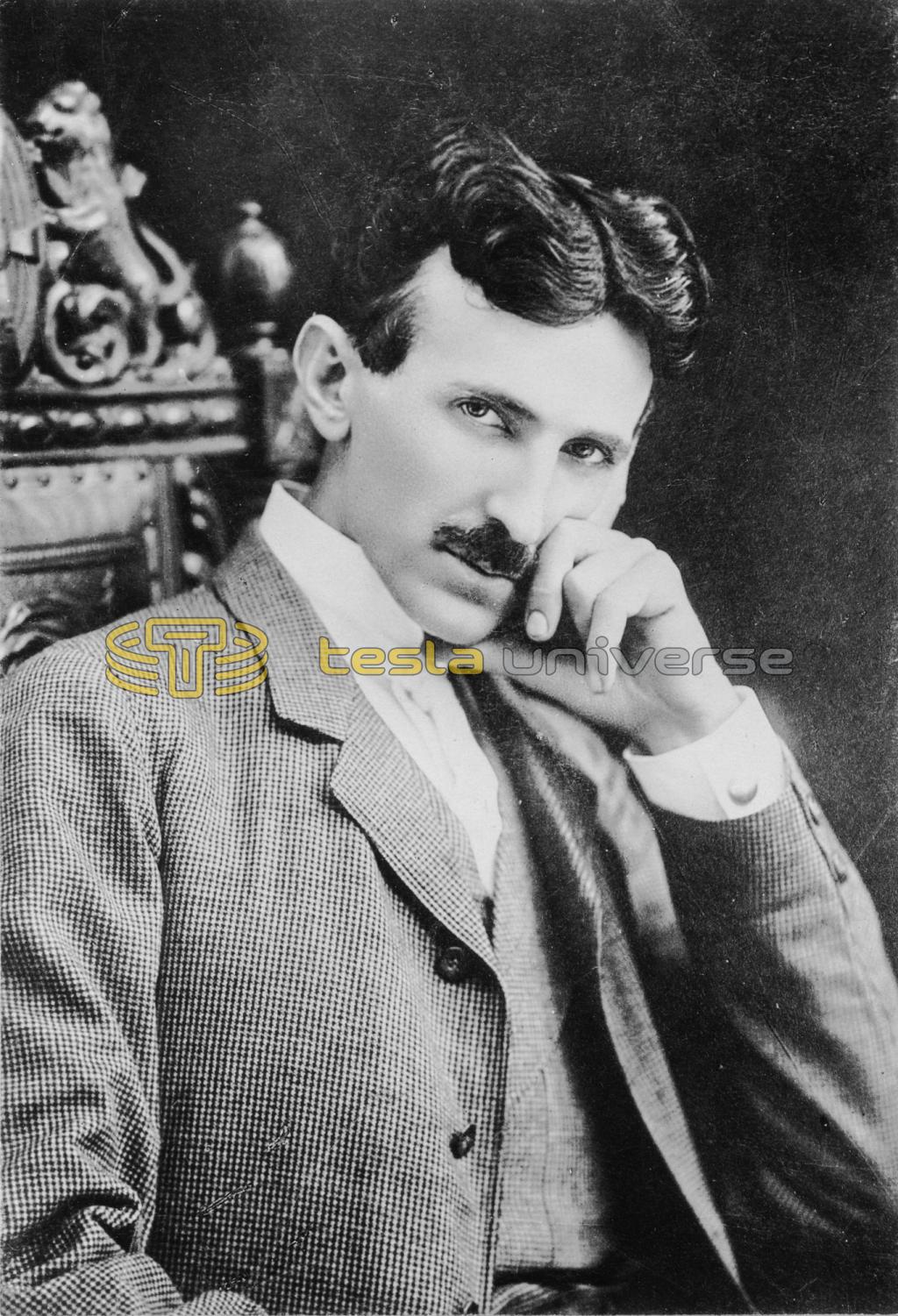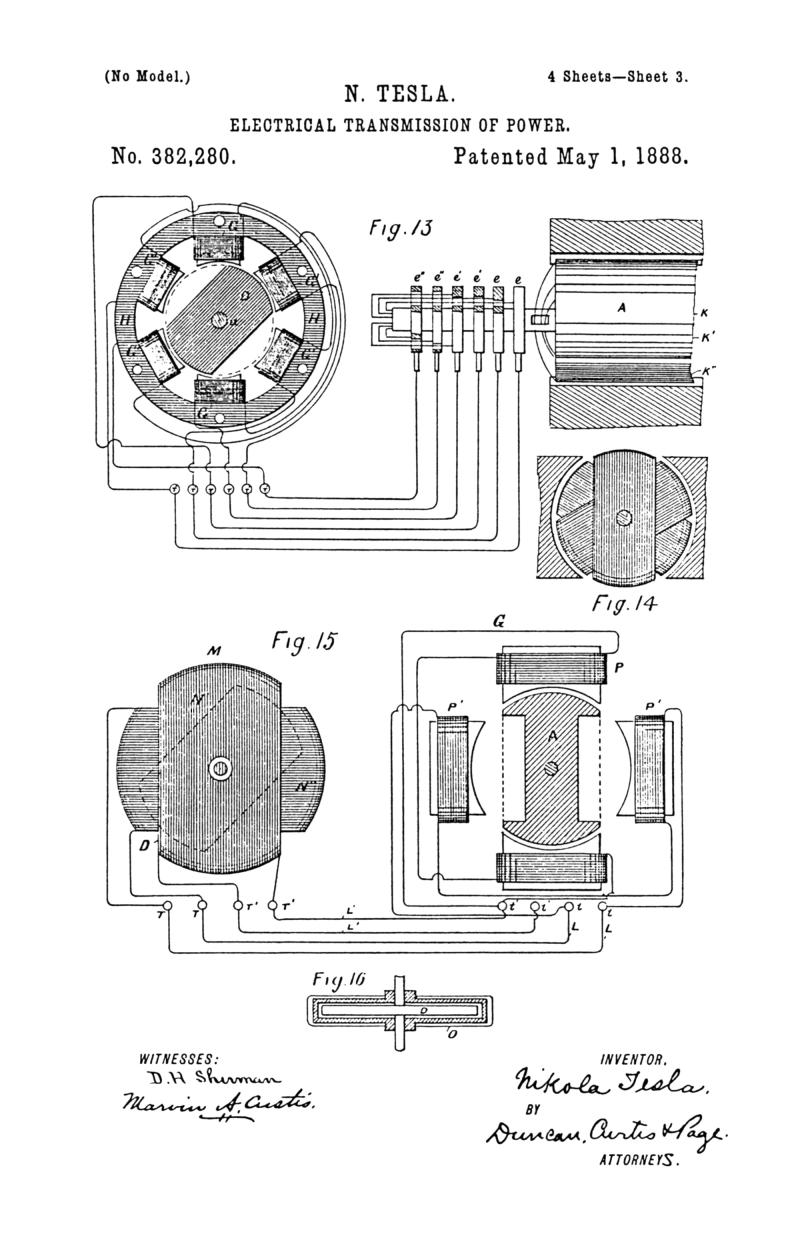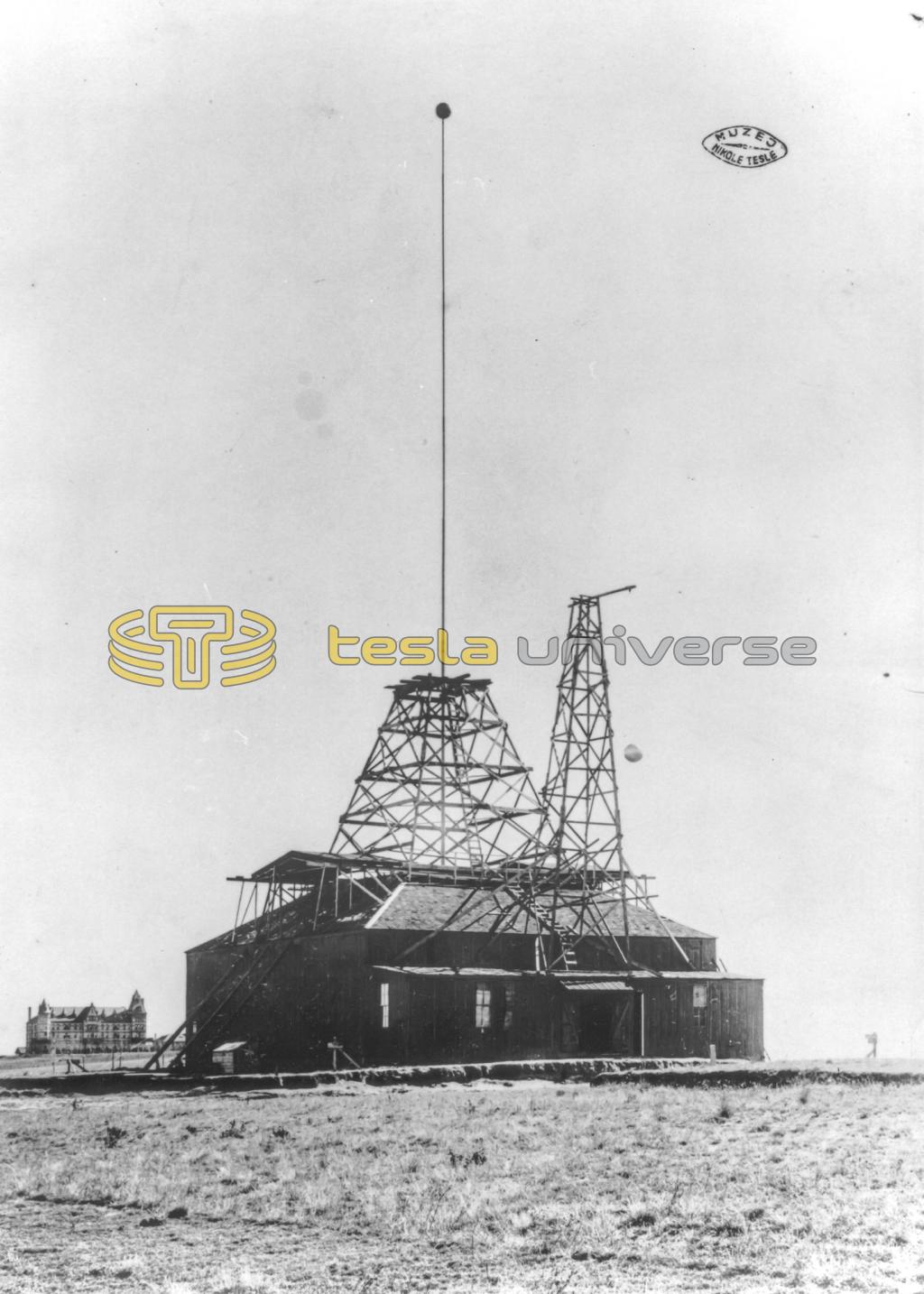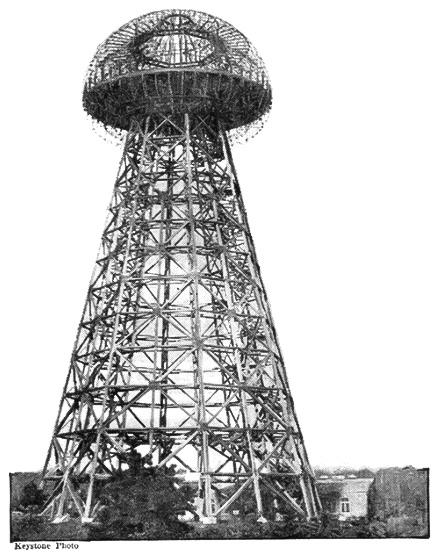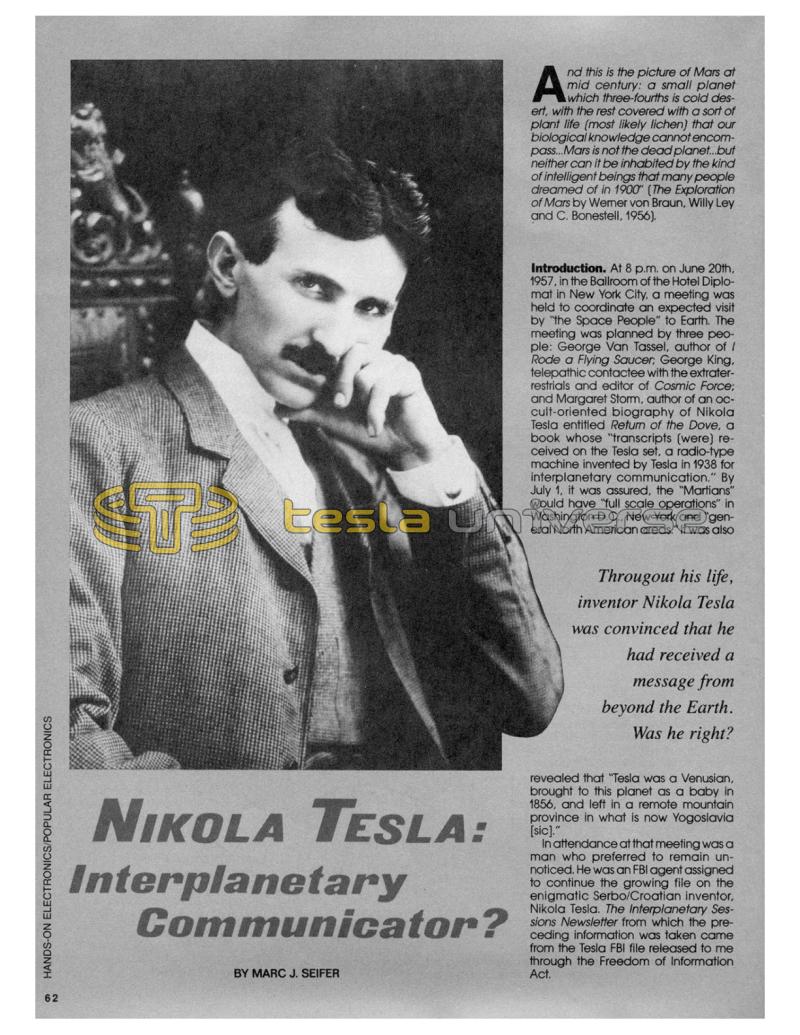
Nikola Tesla Articles
Nikola Tesla: Interplanetary Communicator?
Througout his life, inventor Nikola Tesla was convinced that he had received a message from beyond the Earth. Was he right?
And this is the picture of Mars at mid century: a small planet which three-fourths is cold desert, with the rest covered with a sort of plant life (most likely lichen) that our biological knowledge cannot encompass...Mars is not the dead planet...but neither can it be inhabited by the kind of intelligent beings that many people dreamed of in 1900" (The Exploration of Mars by Werner von Braun, Willy Ley and C. Bonestell, 1956).
Introduction
At 8 p.m. on June 20th, 1957, in the Ballroom of the Hotel Diplomat in New York City, a meeting was held to coordinate an expected visit by the Space People" to Earth. The meeting was planned by three people: George Van Tassel, author of I Rode a Flying Saucer: George King, telepathic contactee with the extraterrestrials and editor of Cosmic Force: and Margaret Storm, author of an occult-oriented biography of Nikola Tesla entitled Return of the Dove, a book whose "transcripts (were) received on the Tesla set, a radio-type machine invented by Tesla in 1938 for interplanetary communication." By July 1, it was assured, the "Martians" would have full scale operations" in Washington D.C., New York and "general North American areas." It was also revealed that "Tesla was a Venusian, brought to this planet as a baby in 1856, and left in a remote mountain province in what is now Yogoslavia [sic]."
In attendance at that meeting was a man who preferred to remain unnoticed. He was an FBI agent assigned to continue the growing file on the enigmatic Serbo/Croatian inventor, Nikola Tesla. The Interplanetary Sessions Newsletter from which the preceding information was taken came from the Tesla FBI file released to me through the Freedom of Information Act.
From this same dossier it is clear that Tesla had been watched in his waning years by J. Edgar Hoover, who wrote, on January 21, 1943, during the height of World War II, "A review of the Bureau files reveals considerable information concerning Nikola Tesla and his inventions." It was just two weeks after the inventor's death, and Hoover feared that Tesla's creations, including his well publicized "death ray," could get into the hands of "the Axis Powers" or the Soviet Union as Tesla's nephew, Sava Kosanovich, ambassador to the newly created Communist country of Yugoslavia was demanding that his uncle's estate be shipped to a museum that was being erected there in his honor. Hoover wrote that "Kosanovich might possibly make certain material available to the enemy."
The Teslascope
Margaret Storm's supposition that Tesla was born from another planet to give our world such devices as the induction motor, fluorescent and neon lights, remote control, robots, the radio, and also our entire electric-power distribution system, stemmed from a colorful history of the inventor's ties to the group-fantasy that life on Mars was a virtual certainty. Storm was also influenced by the times (e.g., the mid-1950's interest in UFO's; the general state of paranoia fueled by the fear of communist infiltration, i.e., the McCarthy period), her readings in Theosophical literature which linked Tesla to the so-called sixth-root race, (the new species of human that was evolving on the planet), and also to her friendship with Arthur Matthews, a bizarre electrician, who as far as I know is still alive and still contends that he and his employer, Tesla, had traveled many times to nearby planets aboard a Venusian spacecraft.
Storm's choice of 1938 as the date for the invention of the interplanetary communicator appears to be a year off. On Tesla's 81st birthday, he announced the invention of what has come to be called the "teslascope."
An article in the July 11, 1937 New York Times quoted Tesla: "I have devoted much of my time during the last year to the perfecting of a new small and compact apparatus by which energy in considerable amounts can now be flashed through interstellar space to any distance without the slightest dispersion."
The article went on to describe "a new form of tube" able to produce potentials in excess of 18 million volts. "It is of ideal simplicity...It will carry heavy currents, transform any amount of energy within practical limits, and permits easy control and regulation of the same."
Schemes and apparatus for an interplanetary communicator for the octogenarian, however, were anything but new. For instance, in a 1907 New York Times editorial, Tesla said, "My magnifying transmitter...can easily bridge the gulf which separates us from Mars." Many years later (1921), Tesla published a short article in the Electrical World entitled "Interplanetary Communication." There, he restated that he had received impulses stemming from Mars in 1899 and that since that time had developed "numerous designs....(for) thoroughly practical apparatus."
Tesla: Cosmic Star of the Gilded Age
Kings of Belgium and Serbia, and upper echelons in England, France, Germany, Austro-Hungary, Italy, and Russia knew the electrical genius intimately. Tesla was an international figure who moved among the very pinnacle of social circles. At the turn of the century, his American friends, enemies, and associates included: Col. John Jacob Astor, perhaps the greatest landowner in New York City and builder of the Waldorf Astoria, Tesla's lodging for over a decade; industrialists George Westinghouse and John Hays Hammond; financiers Henry Clay Frick, builder of the Frick Museum, Equitable Insurance director Thomas Fortune Ryan, J. Pierpont Morgan, investor in many Tesla products and schemes and most powerful economic force on the planet, and banker Jacob Schiff; editors Robert Underwood Johnson of The Century, T.C. Martin of Electrical World who was the compiler of the first Tesla collected works and a biography of Edison, and Joseph Collier of Collier's Magazine; artists such as composer Dvorak and writers Rudyard Kipling and Mark Twain; and, of course, inventors such as Oliver Lodge, Guglielmo Marconi, Elihu Thomson, and Thomas Edison - Tesla's employer from 1884-85 and arch-enemy/competitor for the next 35 years.
Tesla's invention of the induction motor and alternating-current polyphase system, sold to Westinghouse as a 40-patent package for $85,000, plus royalties, in 1888, changed the course of history in a dramatic and intimate way. The electrical genius had conceived a means of sending electricity more than one mile.
Before Tesla, that was about the extent of the budding electric-utility industry's ability to transport energy, and then only to illuminate lightbulbs. After Tesla, power to run factories could be transported hundreds of miles-for example, from Niagara Falls to New York City. Tesla made impossible dreams industrial realities and he was heralded at the time for his brilliance. Remember that when you see a jewel-lit city and surrounding network of illumed surburbia some night, it is a monument to the Serbian Aladdin who believed in interplanetary communication.
After changing the course of history from a future envisioned by Edison backers, which would have required a power station every square mile across the civilized continents, to one containing just a small number of mighty transmitting sources, Tesla decided to go one better. In 1893 he pieced the wireless puzzle together from his own experiments in cordless vacuum lamps and from research by Sir William Crookes, Sir Oliver Lodge, Heinreich Hertz, and Sir William Preece. Tesla discovered that the Earth itself could be used to transmit energy. Thus, the need for constructing hundreds of thousands of miles of transmission lines was unnecessary, for proper apparatus could transport huge amounts of energy from one point on the globe to another without any wires.
The inventor's scheme was actually quite simple. Tesla realized that this giant electromagnet called Earth has resonant frequencies (which today are known as telluric currents). By building giant broadcasting towers to pump large voltages into the earth. and ambient medium, and by building identically designed receiving stations, both in exact mathematical relationships to the size of the Earth and its period of frequency, terrestrial carrier waves would abolish the need for transmission lines. Once power was "jumped" that way from, say, a waterfall to a distant city (i.e., from tower to tower) and converted to more useable frequencies, energy could be transported locally by means of conventional wire transmission lines or via resonant receiving devices such as remote controlled clocks, telephones, teletype, and lighting fixtures. At the same time, Tesla reasoned, even greater charges set up in such a way as to amplify the naturally flowing Earth current could transmit a significant impulse from this planet to another.
Interplanetary Communication
To prove his wireless scheme and begin plans for inauguration of his World Telegraphy System, in 1899, Tesla moved his operations to Colorado Springs where he constructed a laboratory and 200 foot transmission tower with plans of circumscribing the globe with electrical impulses. One summer night, while in his wireless laboratory high in the Rockies, Tesla was engaged in tracking thunderstorms within a radius of 1200 miles with sensitive electrical devices. During that time he received "three fairy taps" on that radar-like apparatus. He speculated in a series of articles, one in 1901 in Colliers Magazine, that those impulses probably originated from intelligent sources exterior to the Earth such as from Venus or Mars.
In the Colliers article, Tesla said "I can never forget the first sensations I experienced when it dawned upon me that I had observed something possibly of incalculable consequences to mankind...the feeling is constantly growing in me that I had been the first to hear the greeting of one planet to another."
Stating in the same article that he "could feel the pulse of the globe as it were," the electric sorcerer rejected the idea that he may have intercepted a mere earthly message from such wireless colleagues as Professor Marble in Connecticut, Dr. Riccia in France, Professor D'Azar in Rome, or rival Guglielmo Marconi who two years later sent "3 fairy taps" across the Atlantic Ocean to capture the imagination of the world with the first transatlantic wireless message.
During the very months Tesla was perfecting long-range wireless transmission and radar tracking devices, Marconi was experimenting with pirated Tesla oscillators in broadcasting the Morse code for the letter S (i.e., dot-dot-dot) over hundreds of miles in Europe and across the English Channel. Modifying the extraterrestrial encounter, recent biographers such as Hunt and Draper, and Cheney, have suggested that Tesla may have picked up the vibrations from a stellar quasar. In either case, however, Tesla was perceived as returning to New York City and his home at the Waldorf, having received messages from outer space.
A few years later, the awful truth dawned upon Tesla: he had received the electromagnetic echo of Marconi's experiments; however, that realization was too painful and Tesla defended vehemently against it in a classic psychoanalytic way: he rationalized by seeking alternative hypotheses and regressing to a more primitive belief structure. In a 1921 article, Tesla admitted as much but disguises it as a denial:
"I was naturally very much interested in reports given out about two years ago that...these supposed planetary signals were nothing else than interfering undertones of wireless transmitters, and since I announced that fact other experts have apparently taken the same view. These disturbances I observed for the first time from 1906 to 1907. At that time they occurred rarely, but subsequently they increased in frequency. Every transmitter emits undertones, and these give by interference long beats, the wavelength being anything from 50 miles to 300 or 400 miles."
To further support the claim that Tesla's reception of so-called Martian signals was based upon self-delusion, it is clear that for at least seven years prior to 1899, Tesla desired to transmit and receive impulses with nearby planets. For instance, in 1896, fully three years before Tesla's alleged ET encounter, the New York Sun published a Tesla interview under the spectacular title "Tesla May Signal to Mars." The inventor said: "If there are intelligent inhabitants of Mars or any other planet, it seems to me that we can do something to attract their attention."
Three years later when he arrived in Colorado, after announcing to the reporters once again that he could signal Mars, Tesla fulfilled his own oft-stated boast by being the first human to hear from the space people. Rather than accept the more likely hypothesis, that deep within himself he probably/possibly knew was the correct one (i.e., undertone receptions from Marconi), Tesla opted for the more exotic scenario of space communications. With each succeeding year, the event became slightly more exaggerated as it took on more and more symbolic importance.
The reclusive Balkan inventor clung to the extraterrestrial motif throughout his life, repeating the speculation publicly on many occasions such as in 1931 for a Time Magazine cover story celebrating his 75 birthday:
"Nothing can be more important than interplanetary communication. It will certainly come some day, and the certitude that there are other human beings in the universe working, suffering like ourselves will produce a magic effect on mankind and will form the foundation of a universal brotherhood that will last as long as humanity itself."
In no way was Tesla alone in his belief in the existence of extraterrestrial intelligence. The theme of space beings wishing to communicate with Earthlings can be traced to biblical tales of burning bushes, aerial wheels of electrum, cosmic commandments, and bright stars traversing the sky to point out the birth of Christ; or to the mythological gods of ancient Rome or Greece such as Zeus, Thor, Hermes, Venus, and Apollo. However, it was modern "scientific" and literary fiction that inspired the more apparent basis for Tesla's suppositions.
The Plurality of Worlds
As anyone who has stared at the star-lit night sky knows, the belief that we are not alone is a very plausible hypothesis. With millions of galaxies each containing billions of stars, there are virtually an infinite number of potential star systems with satellites similar to our own probably capable of sustaining life. This idea, called the plurality-of-worlds hypothesis, is a concept that through the ages has counted numerous scientists among its ranks. Early astronomers such as Bruno, Kepler, Newton, Laplace, and Herschel took that position, along with such modern-day astrophysicists as Willy Ley, Werner von Braun and Carl Sagan.
Naturally, at the same time, numerous artists and authors also have seized that notion and fashioned tales of extraterrestrial travel and intrigue. Two thousand years before Steven Speilberg's movie "ET" earned over $300,000,000, and the phrase "ET phone home" became embraced by the public, Lucian of Samoa, a contemporary of the Greek philosopher Plutarch, wrote The True History, a fable about a sailing ship that was hurled to the moon by a whirlwind. That theme of planetary travel was also echoed by Bishop Goodwin in 1638 when he authored a story about a man who was towed on a sleigh to the same heavenly body, and by Cyrano deBergerac 20 years later in his books Empires of the Sun and Voyage to the Moon.
In 1835, Richard Adams Locke, of the New York Sun created a series of front page articles on astronomer Sir John Hershel and his alleged discovery of advanced life forms on the moon. Locke's hoax, which spread around the world before it was exposed, was predicated on the fact that Herschel was in South Africa at the time, and therefore out of contact with the press. Hershel's supposed discoveries of unicorn-like animals and winged humanoids were made via a marvelous (and fictitious) telescope that weighed 15,000 pounds, was 150 feet long, and could magnify the heavens 42,000 times.
In 1865, Jules Veme reawakened the idea of journeying to the moon, but by the late 1870's, focus shifted to Mars. That planet became the most likely candidate for the home of higher beings for fiction writers and astronomers alike, not only because of its similarity to the Earth in size and position, but also because of the dynamic and changeable nature of its surface as seen by the astronomers. For instance, Mars has ice caps that grow and diminish with the seasons.
The first attempts to create a map of Mars and delineate those lines can I traced back to Bernard de Fontana, Christain Huyghens, and Mr. Cassini in the mid-1600's. More detailed drawings were done by the discoverer of Uranus, the well-known astronomer Sir John Herschel in 1830 and by numerous other scientists such as Mr. Schmidt (1862), R.A. Proctor (1867) and Camille Flammarion (1873).
The year 1877 was a watershed for Martian influence on Earthlings. During a particularly close pass to our planet that year, two fabulous discoveries were made: Mars had its own moons. and its surface was adorned with a matrix of symmetrical furrows.
The first discovery by Professor Asaph Hall confirmed Kepler's supposition of 1610 that two small satellites circled the "Planet of War." That find was of particular importance because it also supported claims for two Martian moons put forward by novelists Voltaire and Johnathan Swift, the former in a philosophical treatise on the Solar System and the latter in his classic tale Gulliver's Travels. In the December 1887 issue of Cornhill Magazine, Astronomer Hall wrote dramatically that the path of one of the moons across the zodiac: "passes...the feet of the Herdsman, the body of the Serpent...over the Bow of the Archer...the head of the Crane, and along the Southern fish... Thence the Martian moon passes athwart the Sea Monster and the River Eridanus...(and) very near the celestial equator of the Martian heavens."
The widely read monthly concluded that "Martian moonlight is but small in amount, and certainly can not go far to compensate the Martians - as compared with us terrestrials." However, no real evidence regarding the prevailing theory of the plurality of worlds was obtained.
That theory was championed by the flamboyant French astronomer and psychical researcher Camille Flammarion in his classic works The Plurality of Worlds and Mars and Its Inhabitants. Both "scientific treatises" were written after his more mystical tale, entitled Stories of Infinity, about a conversation the author had with a comet named Lumen was published.
Flammarion's belief that Mars housed life stemmed not only from his daily studies with his own telescope of the mountains and craters of the planet, but also from the more detailed observation supplied by Italian stargazer Giovanni Schiaparelli, who announced to the world that the Red Planet was etched with geometrical and parallel trails which he named "canali." Renamed "canals," instead of the more literal translation of "channel," Flammarion boldly sug sted that: "these canals may be natural...or they may be grooves excavated by the inhabitants for the distribution of water..."
After discussing the size of the oceans, (which were no larger than the Mediterranean), the changing climates, and a snowfall photographed by Professor Pickering of Harvard in 1890, Flammarion concluded "it is obvious...that the world of Mars is...vigorously alive." He also suggested that due to the lightness of the atmosphere: "the inhabitants of this planet may have received the privilege of flight... May they not rather be like dragonflies fluttering in the air above the lakes and the canals?"
Influenced rather dramatically by those bold words and scientific observations, which appeared in Review of Reviews and North American Review, the Time Magazine and Saturday Evening Posts of the Gay Nineties, the hypothesis that Mars was inhabited by an advanced civilization was given further observational corroboration by Percival Lowell, discoverer (30 years later) of the planet Pluto, and builder of a magnificent telescope in Flagstaff, Arizona.
A descendant of the prestigious Bostonian Lowell family and brother of the president of Harvard University, Percival captured the front page of the New York Times with "Mars Inhabitated" headlines on a number of occasions as he published the results based upon his detailed Martian maps in the prestigious science journals such as Nature, and in a magnificent text published by Macmillian entitled The Canals of Mars: "Suggestive of a spider's web seen against the grass of a spring morning, a mesh of fine reticulated lines overspreads...the globe from one pole to another...That Mars is inhabited by beings of some sort or other we may consider as certain as it is uncertain what those beings may be...Girdling their globe and stretching from pole.to pole, the Martian canal system not only embraces their whole world, but it is an organized entity...the first thing that is forced on us in conclusion is the necessarily intelligent and non-bellicose character of the community which could act as a unit throughout its globe."
Not to be undone, novelists and newspaper columnists embraced this group fantasy with ardor, In 1896, George duMaurier, grandfather of Daphne, wrote the novel The Martian in which he described the telepathic winged beings that descends from no monkey," but are able to excavate, adorn with marble statues, and irrigate the entire planet. H.G. Wells went one better with in his serialized 1897 horror story War of the Worlds, when he had terrible extraterrestrials invade and destroy the Earth. George Lathrop, son-in-law of gothic writer Nathaniel Hawthorne, combatted the Red Planet's warriors on the pages of The New York Journal in 1895 with disintegrating death rays invented by the Wizard of Menlo Park, Tom Edison.
Other scientists such as Lord Kelvin suggested that the light from New York City created a clear signal of progress to the Martians; Elihu Thomson of General Electric brought his telescope to his factories in order to show his workers the canals of Mars with their own eyes!
Tesla and the extraterrestrials
Quite naturally, Tesla, who like the others, had followed the interplanetary developments for decades, did not want to be eclipsed by such competitors as Thomson or Edison. Therefore, he proclaimed boldly that the time finally arrived: communication with our extraterrestrial neighbors had (probably) begun.
Perhaps due in part to a friendly sparring match of spectacular articles, the brother-in-law of George Lathrop, Philadelphia North American columnist Julian Hawthome came to Tesla's aid and authored a series of rather detailed treatises on the inventor's philosophy, laboratory, and fabulous electronic experiments...and also his work in interplanetary communication.
In an article entitled, "And How Will Tesla Reply To Those Signals From Mars?" Hawthorne wrote: "Mars, for example, is several millions years older than this little dot of an Earth of ours... How we stare at the Neanderthal skull and try in vain to reconstruct for ourselves a mode of existence the date of which in contrast with the superiority age of Mars over us, is but as yesterday...Think what prophecies we are hazarding as to the miracles we will achieve before the year 2000...Measuring against that standard, then, to what height shall we have attained this day in a million years?...
"The other day, there happened to Mr. Tesla the most momentous experience that has ever visited a human being on this Earth. Three soft impulses travelling with the speed of light were received by Tesla in Colorado from some Tesla on the planet Mars!
"...No thoughtful man can have much doubt then, that little as we are aware of it, we must for many ages have been subjected to the direct inspection and familiar approach of the men of Mars and of the other older planets. They visit us and look us over...year after year; and report at home: They're not ready yet! But at length a Tesla is born, and the starry men are on the watch for developments. Possibly they guide his development; who can tell?"
Thus, when Margaret Storm suggested that Tesla was a space being, it is clear that her hypothesis was deeply rooted into a well-ingrained belief that extraterrestrial life was a certainty. Her choice of the year 1938 was somewhat arbitrary in terms of pinpointing a specific date for over 40 years of Tesla dabbling with interplanetary devices. The year 1938 may actually have been chosen by Storm for quite another reason, as that was the year John Houseman and Orson Welles terrified America by broadcasting on the radio an updated version of H.G. Wells' classic tale, War of the Worlds.
A Gallup poll taken just a few days after the authentic-sounding broadcast about a Martian invasion, estimated that upward of two million people were psychologically shaken by it. Perhaps fired up by the recent success of the Nazi invasion of Austria, numerous people huddled by their radios and waited for Armageddon.
"When the Martians started coming north from Trenton we really got scared," said one listener. Where another person assumed God was finally punishing humans for their evil deeds, a third radio buff said in resignation to her nephew, "Well, we might as well eat this chicken-we won't be here in the morning."
Tesla's attachment to the Martian hypothesis in the short run fueled controversy and notoriety from admirers and vehement anger from competitors and critics. However, in the long run, those spectacular claims only served to undermine the inventor's credibility and make it more difficult for him to raise the necessary capital for his quite serious inventions in the wireless telegraphy of light, voice, pictures, and power, a project which even to this date has yet to be realized. Eventually and steadily, Tesla's well deserved fame for his patented inventions disappeared from the public eye, as the name of Tesla became associated with the flying saucer crowd, which transformed the Serbian mystic into an extraterrestrial messiah whose secret inventions provided the key for direct communication with the "Great Beings" above.
Epilogue
On May 22, 1983, the batteries on the Viking probe that landed on the Red Planet in 1976 burned out. However, the satellite had served huImanity well: Its robot arm, affectionately named Mr. Badger, which scraped up Martian turf and fed it Earth food, had recorded rather astonishing results. Expecting an effect which would have either increased or decreased the amount of organic material presented, the Martian soil reacted in such a way that both increases and decreases were. achieved. As quoted in the December, 1976 issue of Science, that was called "extraordinary behavior" by NASA scientists Crofton Farmer and Hugh Kieffer.
Although no organic material was discovered and the scientists "warrent(ed) extreme caution in reaching a conclusion concerning the existence of life," Farmer and Kieffer were forced to conclude "despite all hypothesis to the contrary, the distinct possibility remains that biological activity has been observed on Mars." Was Tesla, as he usually had been in all his work, simply ahead of his time again?
